Is Your Mattress Killing You Softly?
As a mattress industry CEO, designer, engineer, and polymer foam expert, I’ve created dozens of mattresses and bedding products made with virtually every imaginable material. From latex to memory foam, formaldehyde based adhesives, flame retardant materials, fire socks, and other components, toxic and even dangerous chemicals can be found in lots of mattresses and bedding products used in the industry even to this day. Things have become safer in recent years, but even ten years ago, where just wasn’t the awareness that your mattress could make you sick, or maybe even worse.
When memory foam was first made, for example, if you walked into a factory that made memory foam, for example, you were required to wear a mask, otherwise, you’d be sick within hours. Before consumers or even manufacturers were aware of the health hazards, these Some memory foam mattresses contain toxic chemicals such as formaldehyde, benzene, and naphthalene. Memory foam may contain isocyanates, which, according to the Occupational Safety and Health Administration, can cause irritation of the eyes, nose, throat, and skin.
I can remember selling a leading brand of memory foam mattresses in my own stores in the Washington, DC, area in the nineties. You’d walk in to open up the store and the first thing that hit you was a nasty chemical smell. Customers would put their noses into the beds, and although they were overwhelmed by the amazing melting sensation of the novel material, there was always the question, “what’s that smell?”.
We didn’t really understand just how dangerous the fumes were back then, and the answer we were told to provide by the manufacturer was, “tell the customer that the smell will go away in a few days”. Actually this was not too far from the truth, as the smell would quickly fade after the customer “aerated their mattress” for a few days, but invariably customers who were super sensitive to volatile organic compounds or the formaldehyde quick set solvent based adhesives used to laminate the many layers of these beds together would call and complain.
The chief complaints were flushing, sore throat, stuffy noses, red rashes, and coughing. The advice we would provide would be to haul the mattress out onto the porch and let atmospheric ozone on a sunny day chip away the odor, and guess what? It worked about 85% of the time.
Still, a solid 10% of customers who would purchase the product would opt to return them, many of whom couldn’t get past the smell of the VOC’s and other noxious fumes.
In 2007 I got out of the memory foam side of the business and created an online store called Habitat Furnishings, which specialized in selling an all natural mattress made with botanically derived latex rubber. And, to glue the layers together, we began to use a non-toxic water based adhesive called Simalfa, a cutting edge product. The hottest pitch we could make as we started to sell thousands of beds was to call our product “The First Chemical Free Mattress”.
The fabric on the outside of the mattress was also very unique. We used an organic cotton cover, and instead of using a synthetic petrochemical derived layer for a flame retardant barrier (required to pass a “burn test”, conducted in third party labs to meet Federal Flammability requirements) we used an organic layer of tightly woven wool. The mattress was well received, didn’t smell, didn’t make any of my customer sick, and we reduced our return rate by 50%, to about 4%, which was considered excellent.
Virtually every mattress contains some petrochemical derived chemicals, especially if there is polyurethane involved, which is almost always used as the bottom, thicker layer of foam mattresses sold in the bed in a box format. The reason for this is that polyurethane foam folds and compresses easily and “reinflates” itself without being damaged upon unfolding in your home.
Polyurethane foams are really inexpensive too, so a mattress manufacturer can build a nice thick and highly presentable product that is largely made of one block of this foam, with various layers of other material, like memory foam, or latex, or charcoal infused foam glued to the top. Again the glue may or may not be water based adhesive. You should always ask this question, as the amount of glue used in mattress fabrication, even for one mattress- can be a quart of this nasty stuff.
Ask specifically if the glue is water based and if you are serious, ask to see the MSDS on all components in the bed you are considering. It’s an official description of all of the ingredients used in the mattress-not with cryptic brand names like “DreamFoam” or “WonderGel”, but rather nomenclature that describes the material components like polyurethane, urethane, or other materials. In long form, this is called a Material Safety Data Sheet.
Often you can find them on a mattress manufacturers website, but I always suggest getting on a chat and simply asking for them. Most of the larger online mattress companies these days have them at the ready for you.
You’d be surprised how many nasty and toxic compounds can be found in the ingredients that are part of a very intimate product that you are in direct contact with, your nose literally buried in the material. Chemicals such as PBDE’s (polybrominated diethyl ethers), TDCPP and TCEP (flame retardants), mercury, leads and other heavy metals, and even formaldehyde as I have mentioned. There are alternatives to components containing these materials, but you can easily avoid them.
Today, the mattress industry has vastly improved the components used in foam or hybrid mattresses that contain foam, coils, natural fibers, and other synthetic materials like charcoal foams, copper infused layers, and even silver infused foams which are bacteriostatic. There are certifications that mattress manufacturers can display on their web site that are legitimate third party organizations that test and certify many component materials, from low VOC memory foam and polyurethane foam, for natural materials like latex, for textiles like organic cotton or wool, and even wood that is used in mattress foundations and box springs.
Certifications such as Oeko-Tex Standard 100 or Greenguard Gold, which certify that various materials have low VOC emissions, or even zero emissions, are highly recommended when you are buying a memory foam or foam bed that is made with several layers. Certi-Pur® US is a popular third party certification brand that tests and certifies hundreds of components used in mattress construction.
Certi-Pur® certified foams cover a spectrum of dangerous compounds that can be found in mattresses. They certify foams that are:
✓ Made without ozone depleters.
✓ Made without PBDEs, TDCPP or TCEP (”Tris”) flame retardants.
✓ Made without mercury, lead, and other heavy metals.
✓ Made without formaldehyde.
✓ Made without phthalates regulated by the Consumer Product Safety Commission.
If you are going to purchase a popular name brand bed in a box type mattress, I advise making sure that the manufacturer uses polyethylene foams which contain fewer contaminants compared to polyurethane. It can be made from either petroleum-based or naturally derived ingredients, so get on a chat and ask for information about the source of the ingredients and test results, in addition to a copy of an MSDS.
If you want to buy a polyurethane or memory foam mattress, find one that is low-VOC certified by a third party certification entity like Oeko-Tex Standard 100 or Greenguard Gold. Avoid beds infused with scents, including toppers and linens, and products with added chemical antimicrobial treatments, which can often be irritating to throat and lungs.
Look for companies that do not use glue, or that use water-based glues like Simalfa, to laminate the layers together if you move around a lot in bed. Buying a mattress that is not adhered together can cause shifting of contents and buckling. Avoid mattresses or covers made of PVC or vinyl, which are sources of phthalates–harmful compounds that affect the reproductive system.
Use a zippered dust-proof pillow and mattress cover to prevent dust mite infestation, too.
If you want to avoid petrochemicals all together, and even rule out low VOC ingredients, your best bed is an all natural, botanically derived latex mattress. Here’s a link to the top latex mattresses that we recommend from our Trusted Dealer Program.
Good Luck! -Marc Anderson, Industry CEO and Bedding Components Expert
the best all natural, chemical free latex mattresses you can buy online
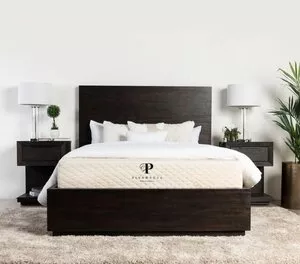
An all latex mattress top to bottom. Sourced latex is high quality. Yielding and bouncy, excellent for side sleepers. 10” finished height, 100 night trial period, 25 year warranty, $1799 for a queen. Free shipping. CLICK HERE TO SAVE $1100and to check them out. Marc’s comments: These guys were my competitors for years. They build the best latex beds I’ve seen. I’ve cut them apart, and love the way they build them, no glue is used. Squishy, scrunchy, silky, buoyant, and luxurious. Freaking awesome in my opinion.
Jul 18, 2018
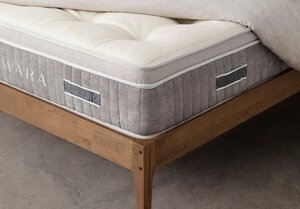
This outstanding natural latex hybrid bed is stuffed with clean, chemical free ingredients and owners love them. You nest upon a breathable organic quilted top, and beneath you, your body floats on 4” of botanical Dunlop latex. Individually pocketed coils suspend and hover you above the base layer of medium high density foam that won’t break down. Delivered with 365 day no questions asked trial and FOREVER warranty! You’ll get $200 off and 10 fruit trees planted in your name. Now, how cool is that?
Jan 11, 2020
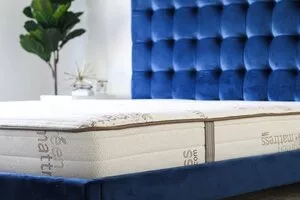
An all natural latex mattress with a lively, buoyant yet medium firm level of support. 10” finished height, 100 night period, 10 year warranty, $949 for a queen. Free shipping. MBG Rating of 5. CLICK HERE TO GET $100 OFF and to check them out. Marc’s comments: The owner of My Green Mattress created this mattress for his daughters who suffered from severe skin disorders. I’d called it a healing bed. One note: it contains coils, which are slightly firmer, but I put in the latex category because of the sumptuous and buoyant feel that its owners love.
Jul 18, 2018

Pure botanical latex, GOTS certified, uses 100% natural cotton cover, 100% natural wool fire barrier, all at a reasonable price. The mattress is reversible offering two firmness options. Overall thickness is 9”, you’ll get a 120 night in home trial, a 20 year factory warranty, and their bed is completely made in the USA. CLICK HERE FOR EXCLUSIVE DEAL. Marc’s comments: They focus on delivering top drawer latex at controlled pricing. Flippable, so two beds in one. Good call on this no frills, but super low pricing option.
Oct 25, 2018
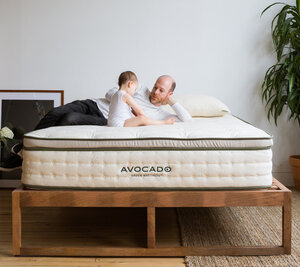
Probably the cleanest, greenest, and safest bed you could buy. Made using only the finest natural and organic materials, including GOLS organic certified latex from tree-tapped sources, 100% GOTS organic certified wool and 100% GOTS organic certified cotton. To you, that means no-off gassing, or chemical textiles. Made in California in their own factories, a purely American company. The latex used is imported from India, collected by hand, and is the silkiest and smoothest botanical latex available. Click here to explore and to purchase.
Aug 5, 2019
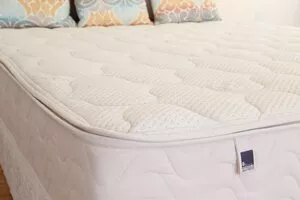
Shipped with three individual layers, allowing you to assemble the mattress in soft, medium, or firm. Organic outer cover, no glue, wool pad pillowtop. Solid 10 year warranty, 365 day no questions asked trial period. Pure dunlop, no synthetic SBR rubber. $220 off if you click here.
Jan 31, 2020